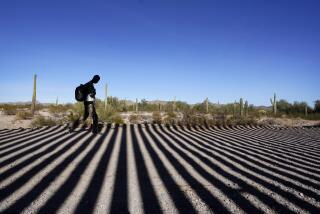What happens next in Syria?

A picture released by Doctors Without Borders on Feb. 16 shows people gathering outside a hospital in Syria’s northern province of Idlib a number of days after the building was hit by suspected Russian air strikes.
- Share via
A U.S.-backed agreement on a “cessation of hostilities” in Syria is supposed to take effect at the end of this week, but there’s been no sign of hostilities slowing — let alone ceasing.
Instead, Russia’s air force, Bashar Assad’s ground forces and even neighboring Turkey have all escalated attacks on the rebels whose five-year-long uprising against Assad is faltering. In northern Syria, missiles and bombs have hit two hospitals in the past week. With Russia’s help, Assad’s forces have nearly surrounded Aleppo, Syria’s largest city and the rebels’ most important base. Meanwhile, Turkey has been shelling Kurdish rebel forces that are allied with the United States.
And even after the non-truce formally goes into effect, both Russia and Syria have served notice that they will continue to attack rebels they consider “terrorists,” a label they have applied to almost anyone opposed to the regime.
As an attempt to stop the war, it’s fair to say that the cease-fire — reached after energetic negotiation by Secretary of State John F. Kerry — has already failed.
So what happens now?
Unless Syria and Russia change course, Assad’s army will surround Aleppo, cutting the city off from outside supply. Rebel supporters and their families, fearing capture, will head for the Turkish border as refugees in greater numbers than before.
Already, more than 50,000 have fled the area around Aleppo in the past month. One Turkish official has warned that, in a worst case scenario, the figure could reach 600,000.
The prospect of more refugees heading toward Europe has Turkey and the members of the European Union terrified. Turkey has long been pressing for a safe zone — an area on its border with Syria where refugees could take shelter and rebels could regroup. This week, Europe’s most powerful leader, German Chancellor Angela Merkel, said for the first time that she favors that approach, too.
“It would be helpful if there could be such an area where none of the parties are allowed to launch aerial attacks — that is to say, a kind of no-fly zone,” she told a German newspaper — adding, somewhat improbably, that she hoped the Assad government would agree to the proposal.
In an interview with The Washington Post, Kerry offered ... a public message to [his] boss, President Obama: We may need to try something new.
Until now, President Obama has rejected the safe zone concept, which would require troops on the ground and protection from the air. The troops could be mostly Turkish, but Turkey has insisted that it wants U.S. participation, at least in the form of air cover. And that would raise the danger of a clash between U.S. and Russian warplanes.
But if Germany and Turkey marshal European pressure in favor of the idea, Obama may have a more difficult time saying no.
“We in the United States aren’t … thinking somehow we’re immune,” Kerry reassured European leaders in Munich last week. “The United States of America understands the near existential nature of this threat to the politics and fabric of life in Europe.”
In an interview with the Washington Post, Kerry offered an undiplomatic hint of what his next step may be.
“What we’re doing is testing [Russian and Iranian] seriousness,” he said. “And if they’re not serious, then there has to be consideration of a Plan B.... You can’t just sit there.”
In Washingtonspeak, that was a public message to Kerry’s boss, Obama: We may need to try something new.
Short term, the Americans hope Kerry’s “cessation of hostilities,” even if limited, will enable the United Nations to deliver food and medicine to Syrian towns that have been under siege for months. “If that works, Kerry would at least deserve credit for saving some lives,” noted Frederic Hof, a former U.S. diplomat who has been critical of Kerry’s diplomacy.
Longer term, Kerry still thinks there’s a chance to persuade Russia and Iran, Assad’s chief foreign backers, that they should help force a change in Syria’s government. But that’s a distant possibility.
Meanwhile, Kerry, at least, will be looking for alternatives to just “sitting there” — including a safe zone. A safe zone wouldn’t end Syria’s civil war, but it would strike a blow against Islamic State (which controls part of the border zone) — and potentially push Syria toward serious peace talks.
The risks are no lower than before, but the costs of the war are mounting — mostly in the form of those refugees heading north. This was a choice Obama hoped to avoid in his final year in office, but he may no longer have that luxury.
Twitter: @doylemcmanus
Follow the Opinion section on Twitter @latimesopinion and Facebook
More to Read
A cure for the common opinion
Get thought-provoking perspectives with our weekly newsletter.
You may occasionally receive promotional content from the Los Angeles Times.










